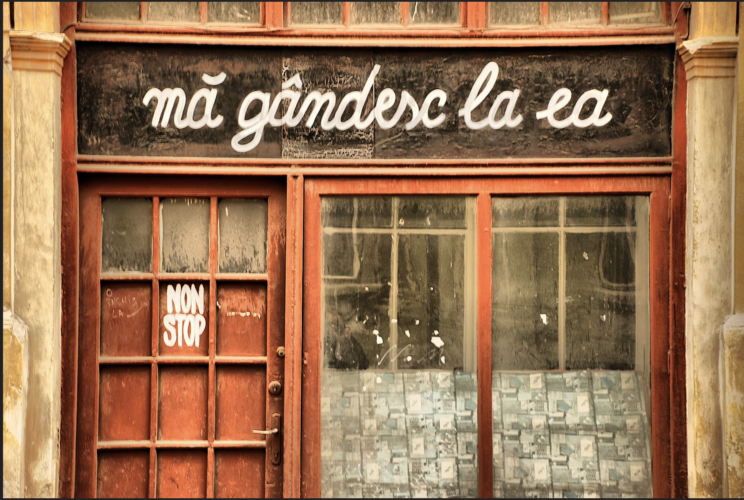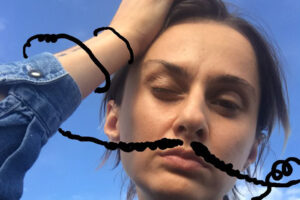July 17, 2020
By Valentina Iancu
Where Are You, Mircea Nicolae?
Gallery 29 was located in an apartment on Vergului street, on the last floor of a typically communist block of flats. The reputation of Pantelimon as portrayed by B.U.G. Mafia in their music, being just as dangerous as Brooklyn, had nothing to do with the silent neighborhood collapsed under the pressure of surviving the never ending post-communist transition. Pantelimon was one of rough post-workers neighborhoods, a so-called bad area of the city. I remember the amazingly beautiful sunset stealing my attention from the poverty porn indicative of the harsh life lived there. The last floor of any communist block of flats burns all summer. The apartment was crowded. I recall myself thinking I could not survive a torrid summer in that flat. Mircea Nicolae lived there together with his mother and sister. He organized 10 exhibitions in his family dining room, between August 2008 and June 2009. Hosting exhibitions at home, for just one day, then giving away the works for free via raffle or tombola was a vivid response to the rise of the art market on the local scene. Back in 2008, Mircea Nicolae was one of the few radical creators in Romania, therefore provocative for any mind. His interventionist practice, highlighting, with small performative gestures, the spread of neoliberal violence all around, is a personal visual poetics of radical sincerity.

Mircea Nicolae – magazin 42. Black and white paint on an abandoned storefront in Sibiu. Text in Romanian – “Thinking about her / non stop” More images here.
“After one year of doing things on the street, I have lately become more and more interested in making objects for a gallery. My motivation came from the large number of artists I have come to admire for their works produced for exhibition spaces. Thus, I chose to build my own gallery in the living-room of my apartment. This space allows me to work independently, following my own interests. It also gives me the opportunity to function as an exhibiting artist and as a curator, at the same time.” (Galeria 29 artist statement). Mircea Nicolae was not just a fine critical observer of reality, he often actively engaged in a process of change. Perhaps a strong example to my point is his intervention in queer history, such as the research based exhibition Do the mountains know? were Mircea Nicolae brought to life a couple of gay artists, Ion Râmnic and István Mihály.
On July 10th 2020, Hortensia Mi Kafchin called me with the news about Mircea Nicolae’s death. Ionuț Cioană (1980-2020) was found dead in his apartment. Ștefan Sava made the announcement on Facebook. The funeral already took place. Everything is vague. I personally fail to believe it. I keep walking, I am not listening to Hortensia anymore. I recall her saying, a few days ago, that once we finish our words, we have to say we die. I wonder if Ionuț Cioană finished his words. He wrote a lot: artistic and curatorial statements, applications and recently, since 2016 he wrote a series of detailed exhibition reviews for Scena9. His lucid eye went deep in the substance of any subject, he was critical without criticizing, explaining art in a simple way. His interests were diverse, oriented with curiosity towards the discovery of recent Romanian art history. I hope to see all these texts together in a volume, it was a pleasure reading them, even if sometimes our perspectives were different.
The Romanian art scene is mourning. I fail to believe and keep looking for the missing point of the story. I light another candle and try to think with Mircea Nicolae. I propose thinking about a second possible truth, less probable, but less disorienting: the death of an artist as an artistic practice, as a work of art, while maintaining the illusion for the person to still be alive. In the post-truth era, we live with the induced paranoia from fake news, conspiracy theories and yet we are often missing the instruments for being able to distinguish what’s real in the news. “Mark Zuckerberg, the founder of Facebook, has spoken of technical systems to detect what people will flag as false before they do it themselves, though it is not clear how close that ambition is to being realized. In march 2017, the corporation launched a pilot scheme that alerted users attempted to share the disputed content and directed those seeking further information to the code of principles adopted by the International Fact-Checking Network.”[1] How deep can this surveillance system go? Is there any way out of this, except death? Is a fake death a way out of the system? How does one survive his own death? The Corona pandemic placed death and fake news in the same sentence, making a good field to explore the possibilities of Thanatos politics.
Following the mourning on social media, I think it is important to consider how “the narcissistic preoccupation of melancholia can be moved into a consideration into vulnerability of others”[2] In her essay Precarious Life: The Powers of Mourning and Violence, queer theorist Judith Butler shifts the attention from personal loss, which is undoubtedly painful, to what makes a life grievable in order to start thinking a politics on death. The inequalities in dying, the heroization of certain deaths and the erasure of others, the politics of memory are subjects left outside contemporary debate. Shifting the focus to inequalities in death, we get some clarity about the systems of oppression in life. In neoliberal times, when everything can be commodified, death is the main amplifier of an artistic practice. One way to politicize this process is to keep Mircea Nicolae’s questions alive and use his amplified voice in death to make his revolution heard. The death of an artist is the passage from memories to history. While the body is becoming absent, following his own path to decay, what is left behind is more alive. The human attempt to escape Death with History, gaining immortality in the collective consciousness is the answer we have in front of our paroxysmal fear of the unknown. Nowadays, for most humans living is a question of surviving, the access to pleasures that make life enjoyable and therefore livable, seems to be reserved only for a small social category. Was Mircea Nicolae one of the bodies expected to have a long life? Sadly not. Understood inside the question of class, Mircea Nicolae death is not unexpected, nor the fact his funeral was not a spectacle. Mircea Nicolae’s death is coherent with his life, and it is, unfortunately, a common death inside his social class. Bodies weaken in time and poverty weakens bodies even more. The promise of long life comes with a price: the artist makes us aware how death is experienced in his social class. Judith Butler proposes a way to push this perspective forward: “If we stay with the sense of loss, are we left feeling only passive and powerless, as some might fear? Or are we, rather, returned to a sense of human vulnerability, to our collective responsibility for the physical lives of one another?”[3]
A sense of political mourning is perhaps to take time to reflect upon unbreakable class differences, as Mircea Nicolae did. How he died, in unknown circumstances, during a torrid summer, in July 2020, alone is his apartment located Vergului street, on the last floor in a typically communist block of flats in Pantelimon, Bucharest is a class struggle.
This text is an obituary. I am not trying to insinuate Mircea Nicolae is not dead, nor that the news posted by Ștefan Sava is fake news. This is simply my own personal way of grieving Mircea Nicolae’s death. Ionuț Cioană (Mircea Nicolae) is one of the names I wish not to be forgotten. His work was an inspiration for my becoming as a thinker and writer. Rest in power, Mircea Nicolae (1980-2020).
[1] Matthew d’Ancona Post Truth. The New War on Truth and How we Fight it Back, Ebury Press, p.118
[2] Judith Butler “Precarious Life: The Powers of Mourning and Violence”, p. 30
[3] Ibid.
POSTED BY
Valentina Iancu
Valentina Iancu (b. 1985) is a writer with studies in art history and image theory. Her practice is hybrid, research-based, divided between editorial, educational, curatorial or management activities ...



